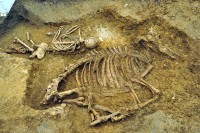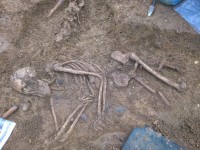 An Anglo-Saxon woman was found buried with a cow in a late 5th century cemetery in Oakington, outside of Cambridge. Anglo-Saxon warriors have been known to be buried with their horses, but this is the first time a woman has been found buried with a domestic animal. In fact, when the animal bones were first excavated, archaeologists assumed it was a horse because they’d already unearthed two other graves in the cemetery of men buried with their horses. They were excited to find a horse buried with a woman because all 31 of the horse burials discovered in Britain are of men. When they realized the animal bones belonged to a cow, their excitement hit the roof. It’s the first cow burial ever found in Europe.
An Anglo-Saxon woman was found buried with a cow in a late 5th century cemetery in Oakington, outside of Cambridge. Anglo-Saxon warriors have been known to be buried with their horses, but this is the first time a woman has been found buried with a domestic animal. In fact, when the animal bones were first excavated, archaeologists assumed it was a horse because they’d already unearthed two other graves in the cemetery of men buried with their horses. They were excited to find a horse buried with a woman because all 31 of the horse burials discovered in Britain are of men. When they realized the animal bones belonged to a cow, their excitement hit the roof. It’s the first cow burial ever found in Europe.
Cows were of enormous value to a community. They were a precious source of meat and dairy which cost a great deal to feed and keep healthy. One cow could make the difference between a community surviving or dying of starvation. Burying the cow would have been an enormous loss for the community to suffer. The woman buried with the cow, therefore, must have been an extremely important person to warrant such a valuable gravemate, especially this early in Anglo-Saxon society.
 Her high status is confirmed by the rich adornments found on her body. Grave goods include copper alloy brooches, three necklaces and hundreds of amber and glass beads.
Her high status is confirmed by the rich adornments found on her body. Grave goods include copper alloy brooches, three necklaces and hundreds of amber and glass beads.
“She also had a complete chatelaine [keychain] set, which is an iron girdle and a symbol of her high status,” [University of Central Lancashire’s Dr. Duncan] Sayer said.
“It indicates she had access to the community’s wealth.
“She is almost certainly a regional elite – a matriarchal figure buried with the objects that describe her identity to the people who attended her funeral.”
A team of archaeologists from Manchester Metropolitan University, the University of Central Lancashire, Oxford Archaeology East and some undergraduate history students from MMU are excavating the Oakington site. It was one of the MMU students — Kate Smith, 19 — who first discovered the woman’s grave. The team has thus far discovered 100 graves, and they estimate there are another 50-60 graves in the cemetery. The dig will continue for another three weeks, but even if they stopped today it would still be one of the most important Anglo-Saxon sites in the country.
For more about the excavation and to keep abreast of anything else they discover, see the Oakington dig Facebook page or follow them on Twitter @oakingtondig.
Is there some sort of relationship between the bodies of the males and the horses? Is there a typical way that human bodies are positioned in this culture?
The female and cow skeletons in the pictures seem to be haphazardly arranged. What evidence other than coincidence would suggest that the cow was “sacrificed” on behalf of the female? Is there any evidence elsewhere that female humans in this culture had been honored in similar ways (other than simply being adorned with lots of jewelry)?
I realize that the prospect of a female being so honored would appeal to our modern sentiments. However, there are other unmentioned possibilities that could be equally plausible–famine, attack, etc. Couldn’t it even be a case where a prominent female was sacrificed for a cow that had some sort of importance that is unknown to us?
It just seems premature to load all of the interpretation onto the cow. Poor thing.
I emailed the lovely people at MMU asking them your questions (and a couple of my own). The answers are indefinite at this point, because the excavation has only just begun. Here’s what they told me:
Maybe the cow fell into the grave when no one was looking?
… this is how it ends when little girls don’t get their pony:
http://kuhreiter.npage.de/
http://file1.npage.de/009384/32/bilder/destiny_kuh_springen.jpg
:hattip:
In reply to the question of whether or not the archaeologists could tell if the cow had been deliberately sacrificed or not… yes it is very difficult and it will usually boil down to guesswork but there were significant signs that point towards a deliberate sacrifice. One of which is that the cows legs were bound together in a way that suggests sacrifice.
I absolutely love your site.. Very nice colors & theme.
Did you create this amazing site yourself? Please reply back as I’m planning to create my own blog and would
love to learn where you got this from or exactly what
the theme is named. Kudos!